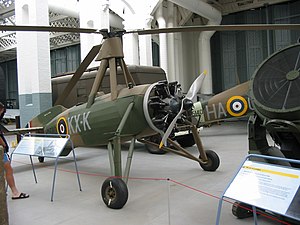Cierva C.30A Autogiro
| C.30 | |
|---|---|
 |
|
| Avro 671 Rota Mk 1 at Imperial War Museum, Duxford | |
| Role | Autogyro |
| Designer | Juan de la Cierva |
| First flight | April 1933 |
| Introduction | 1934 |
| Number built | 148 |
| Variants | Cierva C.40 |
The Cierva C.30 was an autogyro designed by Juan de la Cierva and built under licence from the Cierva Autogiro Company by A V Roe & Co Ltd (Avro), Lioré-et-Olivier and Focke-Wulf.
Before the experimental Cierva C.19 Mk V, autogyros had been controlled in the same way as fixed-wing aircraft, that is by deflecting the air flowing over moving surfaces such as ailerons, elevators and rudder. At the very low speeds encountered in autogyro flight, particularly during landing, these controls became ineffective. The experimental machine showed that the way forward was a tilting rotor hub fitted with a hanging stick extending to the pilot's cockpit with which he could change the rotor plane. This was known as direct control and was fitted to the C.30. The production variant, called C.30A in England, was preceded by several development machines.
The first production design in the series was the C.30, a radial-engined autogyro with a three-blade, 37 ft (11.3 m) rotor mounted on an aft-leaning tripod, the control column extending into the rear of the two cockpits. The engine was the five-cylinder, 105 hp (78 kW) Armstrong Siddeley Genet Major I used in the C.19 series. The fabric-covered fuselage carried an unbraced tailplane, without elevators but with turned-up tips. The port side of the tailplane had an inverted aerofoil section to counter roll-axis torque produced by the propeller. As with most autogyros, a high vertical tail was precluded by the sagging resting rotor, so the dorsal fin was long and low, extending well aft of the tailplane like a fixed rudder and augmented by a ventral fin. The wide-track undercarriage had a pair of single, wire-braced legs and a small tail wheel was fitted. This model flew in April 1933. It was followed by four improved machines designated C.30P (P here for pre-production) which differed in having a four-legged pyramid rotor mounting and a reinforced undercarriage with three struts per side. The rotor could be folded rearwards for transport. The C.30P used the more powerful (140 hp, 104 kW) seven-cylinder Armstrong Siddeley Genet Major IA radial engine.
The production model, called the C.30A by Avro, was built under licence in Britain, France and Germany and was similar to the C.30P. The main alteration was a further increase in undercarriage track with revised strutting, the uppermost leg having a pronounced knee with wire bracing. There was additional bracing to the tailplane and both it and the fin carried small movable trimming surfaces. Each licensee used nationally built engines and used slightly different names. In all, 143 production C.30s were built, making it by far the most numerous pre-war autogyro.
...
Wikipedia
